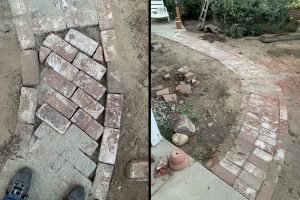Mother Nature proclaimed 2023 “The Year of Projects.” A record wet winter, pleasurable spring and temperate summer created land that was lush and project ready.
Dream: Websites were as lush as the weather, creating desires similar to Christmas. Weather and websites became two legs to my project, a curvy 16-foot walkway joining two patios (no more winter muddy feet). The curvy sidewalk would be followed by lush vegetation, making the patio the best place in my yard. The image lived in my brain for several years, but the third leg of my project—cost—was dive-bombed by installation estimates. Gray concrete walkway ideas moved to the back burner. Pictures on Pinterest created visions of a used brick walkway.
Plan: Planning has many variables including age, physical abilities, knowledge, and time. I knew the length of the walkway; I wanted the bricks to become part of the soil. I searched for used bricks, based on cost and ease of loading into my truck.
Be adaptable: Out of the sunset, a hero spoke. My dad offered antique bricks, “Just get them out of his yard.” Free bricks and medium ease of loading! Understanding the limitation of age and physical ability, I substituted a heavy-duty Radio Flyer wagon (40 bricks per load) for my contractor’s wheelbarrow.
Take your time: I opted to create the border by using bricks lined up end to end. Then, the questions began. What should it look like? Where are the curves? How will it meet each patio, one lower and one higher? Luckily, I was working alone with ample amounts of time. The border of bricks gave a picture of how it would work so I started digging. My idea was to sink the bricks into the soil to hold them in place.
Reality: The walkway was dug out and leveled, sand added as a base. I watered the sand in and started adding bricks. All is well until the first curve, a strong ninety degree left turn. Amazingly, bricks do not bend. I hear every algebra and geometry teacher telling me that I “would need math in my future.” I pull up the bricks and try the corner again. Back to the internet. No geometry teacher dropping clues on turning a tight corner with bricks. Time sitting on the patio looking for an idea. Pull the bricks up again. Start at the other patio. More sitting and observing. Desperate trips to the hardware store. (Yes, the employees were laughing.) I learn about fanning bricks and cutting bricks. I buy a chisel and rubber mallet to break bricks. (I also learn a few songs about mining like “16 Tons,” attributed to Merle Travis, popularized by Tennessee Ernie Ford.) Between the singing and beating bricks, my neighbors joined the hardware store employees in wanting to report me to authorities.
Assess skills needed: My design would require cutting bricks. Chisel and mallet did not work for me like the videos. Even with mining songs. Finally, an angel appeared with an electric grinder saw and a bundle of knowledge. Each cut brick seemed to fill empty holes in different sections. Geometry teachers were applauding.
Accomplishment: It is an amazing feeling of accomplishment to complete and love a project in your yard. My walkway came at a cost of several bags of sand, a mallet, and a chisel. Far less than the plain old concrete sidewalk. 2023 will always be known for me as “The Year of Used Brick with a Curve.”
Julie Silva is a University of California Cooperative Extension Master Gardener of Tuolumne County.




